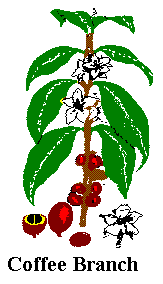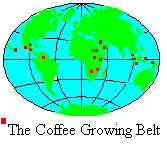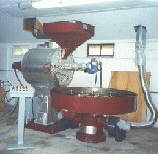

Coffee beans come from the coffee tree (actually it is a tropical evergreen
shrub). It has the potential to grow to 100 feet, however it is kept much
shorter for ease of harvest. The leaves look similar to the leaves of a
laurel bush and the blossoms have a Jasmine like aroma. The average coffee
tree produces an annual yield of 1 to 1 1/2 pounds of roasted coffee. It
takes about 4,000 hand-picked green coffee beans to make a pound of coffee.
Coffee beans are really seeds or pits of the fruit called coffee cherries. These cherries are plump and bright red in color. They look like the cherries we eat, except each cherry normally contains two beans and there is less fruit pulp. An exception is the peaberry, which only grows one bean to a cherry.
 The coffee cherry has a thin skin with a slightly bitter flavor. Next,
comes the fruit, which has a texture similar to a grape and taste quite
sweet. The bean is protected by a parchment, which is covered with a slimy
layer of mucilage. The coffee bean is bluish green in color and is coated
with a thin layer called the silverskin.
The coffee cherry has a thin skin with a slightly bitter flavor. Next,
comes the fruit, which has a texture similar to a grape and taste quite
sweet. The bean is protected by a parchment, which is covered with a slimy
layer of mucilage. The coffee bean is bluish green in color and is coated
with a thin layer called the silverskin.
 The tree grows in tropical regions, between the tropics of Cancer and Capricorn,
that have abundant rainfall, year round warm temperatures averaging 70
degrees Fahrenheit, and no frost. It grows at altitudes ranging from sea
level to 6,500 feet and above. It takes about five years for a coffee tree
to bear its first full crop of beans. It will then be productive for about
fifteen years.
The tree grows in tropical regions, between the tropics of Cancer and Capricorn,
that have abundant rainfall, year round warm temperatures averaging 70
degrees Fahrenheit, and no frost. It grows at altitudes ranging from sea
level to 6,500 feet and above. It takes about five years for a coffee tree
to bear its first full crop of beans. It will then be productive for about
fifteen years.
Growing coffee plants is difficult as the soil warmth is a critical
factor, with the optimum temperature hovering at 27.7 degrees Celsius.
Propagating the plant through cuttings is equally difficult and requires
the maximum of light plus a humidity reading of close to 90%. Rooting can
easily take three or four months.
There are three species of coffee trees:
Depending on where in the world your coffee was grown - it will have its own distinct taste. Even coffee from the various regions of a country will have its own unique flavor, depending on such factors as altitude, rainfall, type of soil, and how it is processed. Although there are many different kinds and blends from almost every tropical region in the world, coffee can be broken down into three major families:
According to legend, coffee was discovered by an Arab goat herder named Kaidi. He noticed that his goats become frisky and danced around the fields after chewing on the berries from certain wild bushes. He tried a few himself, and was soon as overactive as his herd. A monk walked by and scolded him for "partaking of the devil's fruit." However, the monks soon discovered that this fruit could help them stay awake for their prayers.
A second legend tells us that an Arabian named Omar was banished to the desert with his followers to die of starvation. In desperation, Omar had his friends boil and eat the fruit from an unknown plant. The broth saved their lives and their survival was taken as a religious sign by the residents of the nearest town, Mocha. The plant and its beverage were named Mocha to honour this event.
The first drink made from the coffee tree was wine. It was made from coffee cherries, honey, and water. In fact the word coffee has its origins in an old Arabic word "Qahwah", meaning wine. It fell out of favor with the spread of Islam and its sanctions against the consumption of alcohol.
Coffee is indigenous to Kaffa (coffee) region Ethiopia. It was taken to Yeman by the Arabs and cultivated there in the sixth century. The original coffee received its name from the Arabian port of Al Mukkah (Mocca) on the Red Sea. It became world famous because it was the sole source for the world's coffee. With the opening of the Suez Canal the port was by-passed for Aden at the tip of the Arabian Peninsula. Coffee has not shipped from Mocha in over 100 years. In the 1600's, smugglers broke the Arabian monopoly in coffee growing. They took seven seeds of unroasted coffee beans from the port of Mocha to the western Ghats of southern India. In the early 1700's, the Dutch began cultivating descendants of the original plants in Java.
Quality coffees must be picked by hand, a process that takes from three to four visits per tree each year. This is because coffee cherries do not ripen at the same time. A branch of a tree might simultaneously bear blossoms, green fruit, and ripe cherries. A good picker can pick about 200 pounds of coffee cherries in one day. This equals about 50 pounds of green coffee beans or 39 pounds of roasted coffee. Once the coffee cherries have been picked, the beans must be removed from them. Three methods may be used in the extraction process:
After the wet or dry process, a mill removes any remaining parchment and the silverskin - a thin covering that clings to the bean.
 While roasting coffee in a large commercial company is simply science,
specialty roasters use both art and science to achieve the ultimate roast.
Specialty coffee is roasted in small batches. The green coffee beans are
placed in a hopper, which pours them into a rotating drum located on the
inside of a roaster. The roaster is pre-heated to around 400 degrees F.
by gas flames. It is kind of a cross between a hot-air popcorn popper and
a clothes dryer. After five to seven minutes the beans turn yellow, indicating
that they have lost about 12% of their moisture. Now they begin to make
a crackling noise that reminds you of popcorn popping. They are actually
popping open, which causes them to double in size.
While roasting coffee in a large commercial company is simply science,
specialty roasters use both art and science to achieve the ultimate roast.
Specialty coffee is roasted in small batches. The green coffee beans are
placed in a hopper, which pours them into a rotating drum located on the
inside of a roaster. The roaster is pre-heated to around 400 degrees F.
by gas flames. It is kind of a cross between a hot-air popcorn popper and
a clothes dryer. After five to seven minutes the beans turn yellow, indicating
that they have lost about 12% of their moisture. Now they begin to make
a crackling noise that reminds you of popcorn popping. They are actually
popping open, which causes them to double in size.
 Since each variety and lot of beans requires a different roast length,
consistent rapid-firing samples of the beans are taken during the roasting
process. This is done by using a trier - a spoon-like prong that pulls
samples of coffee from the roaster. Roastmasters uses both smell and sight
to determine when the type of roast they want has been achieved. Just before
the beans reach their optimum color, they are released into a large metal
pan called a cooling tray. Large fans air-cool the coffee to room temperature
in about four minutes. During this time period the coffee will darken one
final shade.
Since each variety and lot of beans requires a different roast length,
consistent rapid-firing samples of the beans are taken during the roasting
process. This is done by using a trier - a spoon-like prong that pulls
samples of coffee from the roaster. Roastmasters uses both smell and sight
to determine when the type of roast they want has been achieved. Just before
the beans reach their optimum color, they are released into a large metal
pan called a cooling tray. Large fans air-cool the coffee to room temperature
in about four minutes. During this time period the coffee will darken one
final shade.
The major time lengths of roasting are:
Roasted coffee releases carbon dioxide. Most of it is released within the first few hours. At this time, oxygen cannot harm the coffee. This is because the pressure of the carbon dioxide being released from the bean is greater than the air pressure around it. Once the rate of the carbon dioxide being released begins to decay then the pressure drops, which allows flavor robbing oxygen to attack the bean. Oxygen is one of the worst enemies of coffee...it is what causes it to go stale.
Quality roasters either produce small batches and ship them right away, or package them immediately in air tight bags that have one-way-valves (sometimes called belly-buttons) which allow the remaining carbon dioxide to escape, but do not allow oxygen to enter. The coffee can also be placed in hoppers that are pumped full with nitrogen gas to replace the oxygen. The nitrogen gas is inert, so it does no harm to the roasted coffee beans. The coffee can then be allowed to sit for six to eight hours to allow the majority of the carbon dioxide to be released before being packaged.
There are two other elements that are harmful to roasted coffee:
